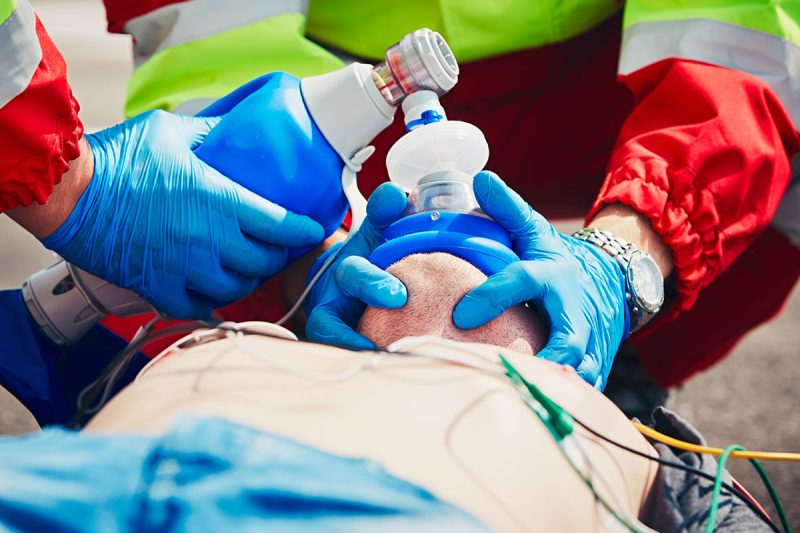Study finds poor ventilation use during CPR for out-of-hospital cardiac arrest

News Release
Monday, November 13, 2023
NIH-supported findings suggest improved techniques for rescue breathing could save more lives.
The ventilation technique, also known as rescue breathing, commonly used during cardiopulmonary resuscitation (CPR) for people with cardiac arrest is often performed poorly by professional emergency responders, and this ineffective strategy is linked to significantly worse patient survival rates, according to a study supported by the National Institutes of Health. Ventilation involves administering breaths to a patient to provide life-sustaining oxygen and inflate the lungs when they stop breathing or during cardiac arrest, when the heart suddenly stops pumping blood. Among the nearly 2,000 people in the study who received CPR for out-of-hospital cardiac arrests, those who were given a higher number of effective ventilations had survival rates three times greater than those who were given fewer ventilations.
The study, funded largely by the National Heart, Lung, and Blood Institute (NHLBI), part of NIH, could lead to improved CPR guidelines and practices among emergency responders and potentially save more lives. Its findings were published in the journal Circulation and simultaneously presented at the American Heart Association’s Resuscitation Science Symposium 2023 in Philadelphia.
“This is one of the first studies to measure the quality and frequency of ventilations used during CPR,” said study leader Ahamed Idris, M.D., director of emergency medicine research at the University of Texas Southwestern Medical Center in Dallas. “While we suspected that better ventilation was going to show some benefit to patients, the result that we got was much more than we expected. It was very surprising.”
Each year in the United States, more than 356,000 people have out-of-hospital cardiac arrests, and only about 10% of them survive, according to the American Heart Association. Idris estimated that if more emergency responders performed CPR according to resuscitation guidelines – that is, giving four effective ventilations per minute and using proper techniques – about 15,000 more people might get to the hospital alive and leave alive. However, many responders are falling short of that goal, showing effective lung ventilations as few as two over 10 minutes, with potentially serious consequences, according to the study.
For the study, the researchers analyzed cardiac defibrillator readings, including measurements of ventilation frequency, that were recorded for 1,976 people who were given standard CPR by emergency responders from June 2011 to May 2015 in six cities in the United States and Canada. Standard CPR is defined as 30 cycles of chest compressions interrupted by brief pauses, during which two breaths are administered through a bag-mask device, which is a portable instrument used by professionals that delivers oxygen through a face mask using a squeezable air bag.
From the start of chest compressions to the placement of an advanced airway device — a tube placed directly in the airway to keep it open — the average duration of the CPR procedure ranged from 10 to 15 minutes.
The researchers then compared the ventilation measurements to the patients’ health outcomes after reaching the hospital. To do this, they divided the patients — 66% male and 65 years old on average — into two groups: Patients who received a higher number of ventilations (about 12 on average during the CPR session) and patients who received a lower number of ventilations (about two on average per session). Patients in the group with the higher number of ventilations had better clinical outcomes, including a three times higher rate of survival-to-hospital discharge, compared to the group with lower ventilation numbers (13.5% vs 4.1%).
In addition, patients in the higher ventilation group experienced a resumption of a sustained heart rhythm in greater numbers than did those in the lower ventilation group (40.7% vs 25.2%). Patients in the higher ventilation group also had a higher survival rate with good neurological outcomes (10.6% vs 2.4%), meaning they showed a low probability of brain damage and could function normally.
Researchers note several factors may account for the low ventilation frequency measured. One is that ventilation is not being measured when using a bag-mask device. As a result, emergency medical technicians or EMTs don’t know when their ventilation attempts are ineffective. A second factor is the use of poor CPR techniques or mechanics that result in air leaks when using a bag-mask device. Another factor is inconsistent use of a device used to keep the tongue from blocking the airway while a patient is on their back. Emergency medical services agencies should provide the means for paramedics to monitor and measure ventilation when a bag-mask device is used, researchers said.
“In the recent past, research on CPR has focused on increased chest compressions, which have significantly improved survival. This new study points out that we also need to try to improve ventilation efforts moving forward,” said George Sopko, M.D., M.P.H., program director of the resuscitation branch of NHLBI’s Division of Cardiovascular Sciences and a medical officer.
This work was supported by NHLBI grant awards R21 HL156196-02 and multiple cooperative agreements (5U01 HL077863, University of Washington Data Coordinating Center; HL077867, University of Washington; HL077871, University of Pittsburgh; HL077881, University of Alabama at Birmingham; HL077885, Ottawa Hospital Research Institute; HL077887, University of Texas Southwestern Medical Center; HL077885 and FAS 06-2603, University of British Columbia). For a more complete funding disclosure and list of authors, please see the full Circulation research article.
About the National Heart, Lung, and Blood Institute (NHLBI): NHLBI is the global leader in conducting and supporting research in heart, lung, and blood diseases and sleep disorders that advances scientific knowledge, improves public health, and saves lives. For more information, visit www.nhlbi.nih.gov.
About the National Institutes of Health (NIH):
NIH, the nation’s medical research agency, includes 27 Institutes and Centers and is a component of the U.S. Department of Health and Human Services. NIH is the primary federal agency conducting and supporting basic, clinical, and translational medical research, and is investigating the causes, treatments, and cures for both common and rare diseases. For more information about NIH and its programs, visit www.nih.gov.
NIH…Turning Discovery Into Health®
Study
Idris, A, et al. Bag-Valve-Mask Ventilation and Survival From Out-of-Hospital Cardiac Arrest: A Multicenter Study. Circulation. DOI: 10.1161/CIRCULATIONAHA.123.065561








